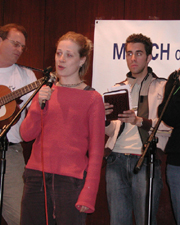

Mary Albino( top photo)
and Guerlyne Mercier (bottom photo), along with other participants in
a tour of Holocaust sites, gave expression to their experience in a
talent show.
Photos by Dafna
Lorber
|
by Barbara Black
Peter Côté and two Concordia students spent 10 days in May
visiting the somber sites of the Holocaust in Poland with students and
student advisors from all over the world.
Côté undertook the trip as a university chaplain, and carefully
chose his companions, as he says, not only because they would appreciate
the significance of the tour, but because they are likely to share their
experience with others in a meaningful way.
Mary Albino is a student in the Liberal Arts College and Religious Studies.
Guerlyne Mercier graduated last year in psychology and is now in Toronto,
doing her Master’s in education; she intends to teach elementary
school.
The tour is called the March of Remembrance and Hope, and is open to Jews
and non-Jews alike. It was organized and partly underwritten by the same
Israel-based organization that sponsors the March of the Living tours
by Jewish high school students.
The tour was also supposed to go to Israel, to see the hope and rebirth
that came out of the grim war experience, but the Israel leg of the trip
was cancelled. Because of the U.S. State Department’s advisory against
its citizens’ travel to Israel because of political unrest, the American
institutions involved in the tour couldn’t get insurance coverage
for their students.
However, Côté said that the trip, which included visits to
former concentration camps, was an extraordinary experience. There were
385 participants, from Canada, the U.S., South Africa, China, Japan and
Europe. They were divided into manageable groups of about 35. A Holocaust
survivor accompanied each group, and they had access to an expert guide.
Their program of lectures, seminars and tours was a full one, starting
at 8 a.m. and continuing until midnight every night.
Poland had a huge, deeply rooted Jewish community of about 3.5 million
before the war, of whom about 3 million were killed. Now, the visitors
were told, there are only about 5,000 active members of the Jewish community,
plus about 20,000 others. However, Côté pointed out that
the Poles themselves suffered in the Nazi occupation; about 3 million
of them died, as well.
The visits to the camps were overwhelming, Côté said. Auschwitz
and Birkenau are separated by about 3 km (that road is the site of a commemorative
walk, or march).
“There is the famous gate, with its incredibly cynical slogan, ‘Work
Will Make You Free,’” he said “The barracks are filled
with displays. One contains tons and tons of human hair, behind glass.
Another is filled with shoes.”
The concentration camp of Majdanek, near Lublin, birthplace of the Yiddish
writer Isaac Bashevis Singer, was devastating for other reasons.
“The camp was a stone’s throw from the city,” Côté
recalled, “and unlike Auschwitz and Birkenau, the Nazis didn’t
have a chance to try to destroy the evidence. Everything is intact, even
the cans of the gas. The doors of the ovens are open. You can look up
at the nozzles where the gas came out.”
Finally, some of the participants brought a special dimension to the tour.
Five of the students were Rwandan refugees from Toronto, who had seen
their parents, sibling and friends die in the conflict between Hutus and
Tutsis.
Côté said that the presence of these young people, so recently
involved in another genocide, were a grim reminder that the slogan adopted
by Holocaust survivors: “Never again,” has not been heeded,
and there is much to be done.
|
|
|



